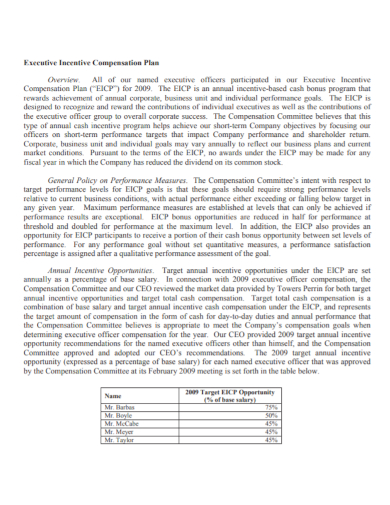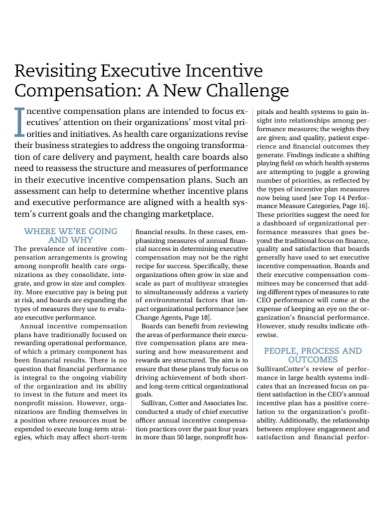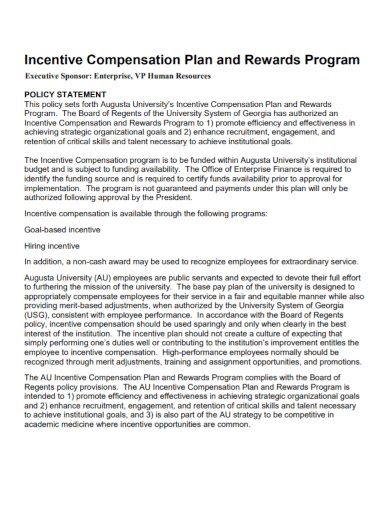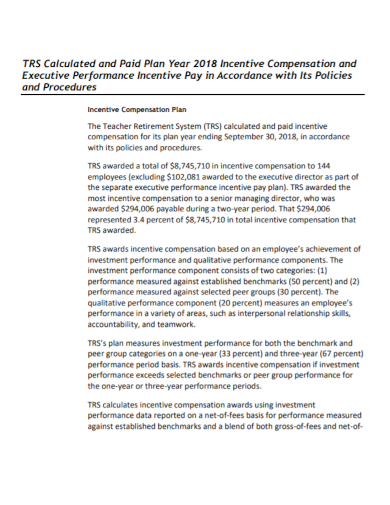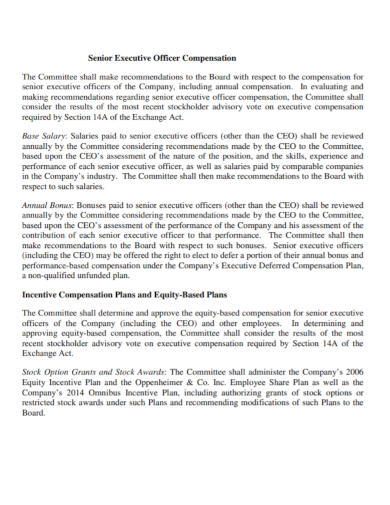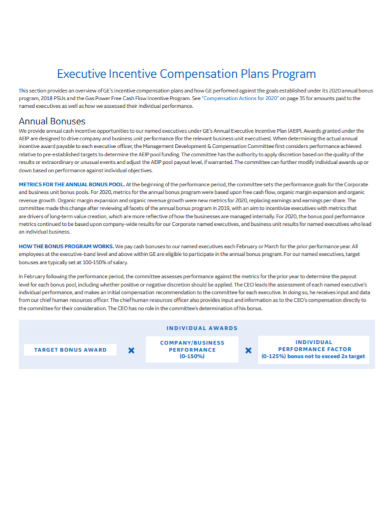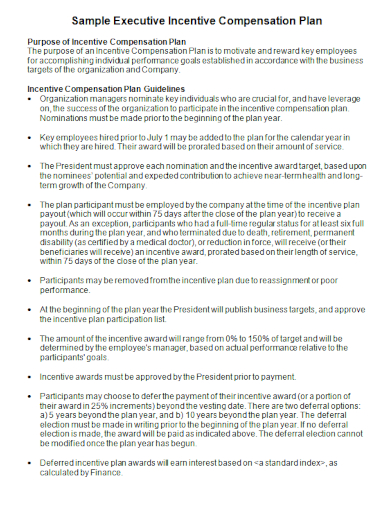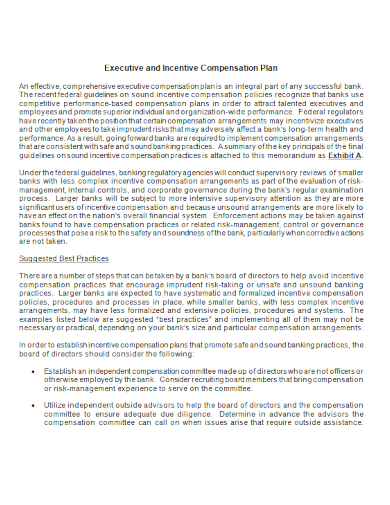Employees are motivated by incentive programs to push and challenge themselves to reach higher levels of productivity. This, in turn, translates to more profits for your business. Everyone understands that productivity is critical to a company’s success. Productivity drives business, so what motivates them? Incentives are a terrific method to keep your employees motivated to accomplish their jobs to their full potential. Thus, it’s critical to plan and set up incentive and benefit programs for the sake of your business. In this article, we provide you with free and ready-to-use templates of Executive Incentive Compensation Plans for you to use. Keep on reading to find out more.
8+ Executive Incentive Compensation Plan Samples
1. Executive Performance Incentive Compensation Plan
2. Executive Incentive Compensation Plan
3. Revisiting Executive Incentive Compensation Plan
4. Executive Sponsor Incentive Compensation Plan
5. Executive Incentive Compensation Year Plan
6. Senior Executive Incentive Compensation Plan
7. Executive Incentive Compensation Program Plan
8. Sample Executive Incentive Compensation Plan
9. Standard Executive Incentive Compensation Plan
What Is an Executive Incentive Compensation Plan?
This Executive Incentive Plan allows for a quarterly cash incentive based on the company’s achievement of net revenue and net operating income plan goals, as well as other business objectives. It’s the additional income employees get on top of their base wage for achieving a specified level of performance. In the end, any executive incentive compensation plan should be designed to encourage top executives to improve the company’s performance in comparison to previous years and to competitors for the benefit of all shareholders.
How to Make an Executive Incentive Compensation Plan
Making an Executive Incentive Compensation Plan rests upon the role and responsibility of the Human Resource Management department. The most fundamental duty of an HR professional is to inform management about the benefits, costs, and range of options available when initiating or enhancing an executive compensation program. Aside from the variety of free compensation plans provided above, you can also try to make one of your own from scratch to personalize it to your own workforce. As such, here are some general components you should remember as you write one up:
1. Set the plan’s metrics.
Metrics are crucial in any effort to improve organizational performance. Executive compensation schemes take a lot of time and effort, so companies should be sure they are getting their money’s worth. The metrics should provide a baseline for where the company is before the changes are implemented, and then measure the results using the same methods at the end of a set period of time.
2. Carefully consider the design of the compensation plan.
A long-term pay plan with performance-based incentive vehicles can assist in striking this equilibrium. Organizations must balance shareholder alignment, performance-based pay, recruitment and retention, and cost vs perceived value when designing a successful executive compensation plan.
3. Create a mock-up of the employee benefit schemes.
Executive remuneration packages usually contain a number of perquisites or perks, which are non-cash benefits. Special perks and fringe benefits have long been utilized by employers to attract, reward, and boost the productivity of executives. These are usually non-cash fringe benefits that are given in addition to salaries or incentives and provide an instant financial reward.
4. Agreements on compensation should be disclosed.
The different parts of direct and indirect compensation that is included in an executive’s pay package are should be explicitly written out in a formal employment agreement that could span years.
FAQs
What is an example of an incentive compensation?
Cash, including commissions, year-end bonuses, sign-on bonuses, and performance bonuses are all examples of incentive compensation. Company stock options or shares.
What makes a good incentive benefit for employees?
A successful incentive scheme must be appealing enough to inspire performance while still being realistic enough to avoid discouraging personnel.
What causes incentive plans to fail?
Incentive schemes that aren’t purposefully linked to the company’s strategy risk encouraging actions that are at odds with the declared strategy. One of the most common flaws in incentive compensation plans is that they fail to account for all of the major factors that contribute to the company’s performance.
A satisfied employee is more productive and has a favorable impact on the rest of the organization. It’s impossible to be pleased, though, when an employee feels undervalued or that their efforts go unnoticed. Download our customizable and printable Executive Incentive Compensation Plans as it is a great way to boost employee happiness and work satisfaction!
Related Posts
FREE 9+ 30-Day Marketing Plan Samples in PDF | MS Word | Apple Pages | Google Docs
FREE 3+ Sales Team Action Plan Samples in PDF | MS Word | Apple Pages | Google Docs
Marketing Plan For Small Business Samples
FREE 7+ Fashion Business Plan Samples in PDF
FREE 10+ Sprint Planning Samples In MS Word | Google Docs | PDF
FREE 10+ Wedding Planning Samples in MS Word | Apple Pages | Powerpoint | PDF
FREE 9+ Monthly Study Planner Samples in PSD | Illustrator | InDesign | PDF
FREE 9+ Sample Curriculum Planning Templates in PDF | MS Word
FREE 10+ Teacher Development Plan Samples in MS Word | Google Docs | Apple Pages | PDF
FREE 10+ Basketball Practice Plan Samples in PDF
FREE 12+ School Business Plan Samples in PDF | MS Word | Apple Pages | Google Docs
FREE 7+ Client Strategic Plan Samples in PDF | MS Word
FREE 11+ Trucking Business Plan Templates in PDF | MS Word | Google Docs | Pages
FREE 7+ Small Hotel Business Plan Samples PDF | MS Word | Apple Pages | Google Docs
FREE 14+ Bakery Business Plans in MS Word | PDF | Google Docs | Pages


